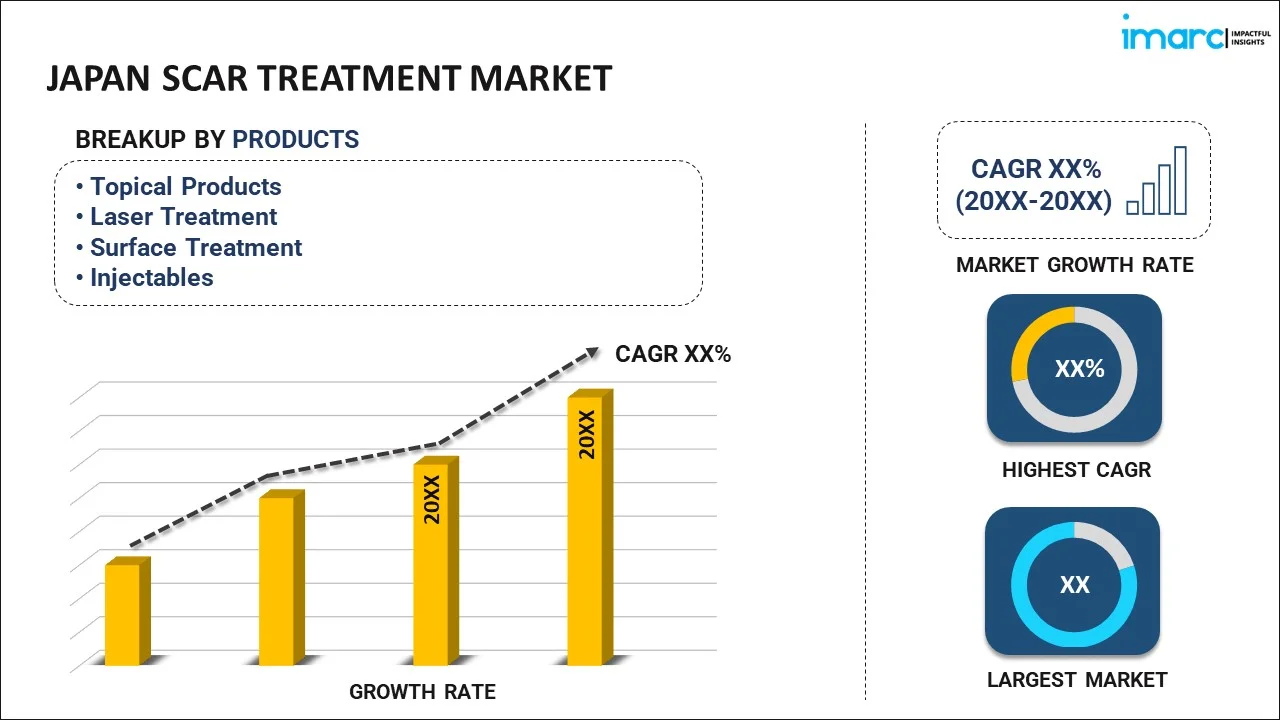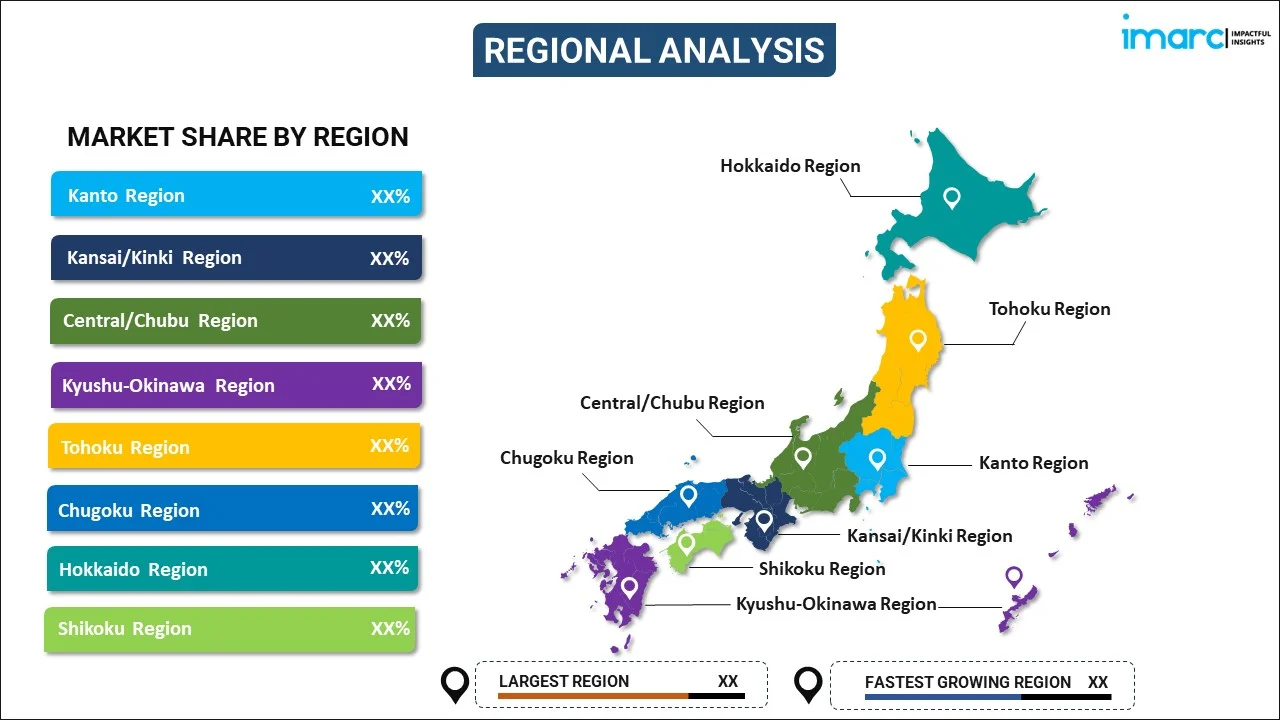
Japan Scar Treatment Market Report by Product (Topical Products, Laser Treatment, Surface Treatment, Injectables), Scar Type (Atrophic Scars, Hypertrophic and Keloid Scars, Contracture Scars, and Others), End User (Hospitals, Clinics, Homecare, and Others), and Region 2025-2033
Market Overview:
Japan scar treatment market size reached USD 780.2 Million in 2024. Looking forward, IMARC Group expects the market to reach USD 2,481.4 Million by 2033, exhibiting a growth rate (CAGR) of 12.7% during 2025-2033. The increasing cases of skin conditions, such as acne, burns, surgical procedures, and injuries, that can lead to the development of scar, are driving the scar treatment market.
|
Report Attribute
|
Key Statistics
|
|---|---|
|
Base Year
|
2024 |
|
Forecast Years
|
2025-2033
|
|
Historical Years
|
2019-2024
|
| Market Size in 2024 | USD 780.2 Million |
| Market Forecast in 2033 | USD 2,481.4 Million |
| Market Growth Rate (2025-2033) | 12.7% |
Scar treatment involves various methods to minimize the appearance of scars resulting from injuries, surgeries, or skin conditions. Common scar treatments include topical creams or gels containing ingredients like silicone or vitamin E, which can help hydrate the skin and improve its texture. Steroid injections can also be used to flatten and soften raised scars, such as keloids or hypertrophic scars. For more severe scars, procedures like laser therapy, microdermabrasion, or chemical peels may be recommended to resurface the skin and reduce discoloration. Surgical scar revision is another option, where a surgeon may remove the old scar tissue and rejoin the skin edges for a more aesthetically pleasing result. Ultimately, the choice of scar treatment depends on the type and location of the scar, as well as individual preferences and skin type. Consulting a dermatologist or plastic surgeon is advisable to determine the most appropriate treatment plan for each specific case.
Japan Scar Treatment Market Trends:
The scar treatment market in Japan is experiencing robust growth due to several key drivers. Firstly, the increasing awareness of cosmetic appearance and the desire for flawless skin are propelling the demand for scar treatment products. Moreover, the rising prevalence of skin injuries resulting from accidents, surgeries, or burns has augmented the patient pool seeking scar management solutions. Furthermore, technological advancements in scar treatment options, such as laser therapy, micro needling, and silicone-based products, have expanded the array of choices available to patients and healthcare professionals alike. Additionally, the growing geriatric population, which is more susceptible to scar formation due to slower wound healing, is a significant driver in the market. In addition to this, the expanding healthcare infrastructure and the availability of various over-the-counter scar treatment products are also contributing to market growth. Moreover, the increasing adoption of minimally invasive procedures and the surge in elective cosmetic surgeries is expected to drive the scar treatment market in Japan in the coming years.
Japan Scar Treatment Market Segmentation:
IMARC Group provides an analysis of the key trends in each segment of the market, along with forecasts at the country level for 2025-2033. Our report has categorized the market based on product, scar type, and end user.
Product Insights:

- Topical Products
- Gels
- Creams
- Oils
- Sheets
- Others
- Laser Treatment
- Surface Treatment
- Injectables
The report has provided a detailed breakup and analysis of the market based on the product. This includes topical products (gels, creams, oils, sheets, and others), laser treatment, surface treatment, and injectables.
Scar Type Insights:
- Atrophic Scars
- Hypertrophic and Keloid Scars
- Contracture Scars
- Others
A detailed breakup and analysis of the market based on the scar type have also been provided in the report. This includes atrophic scars, hypertrophic and keloid scars, contracture scars, and others.
End User Insights:
- Hospitals
- Clinics
- Homecare
- Others
The report has provided a detailed breakup and analysis of the market based on the end user. This includes hospitals, clinics, homecare, and others.
Regional Insights:

- Kanto Region
- Kansai/Kinki Region
- Central/ Chubu Region
- Kyushu-Okinawa Region
- Tohoku Region
- Chugoku Region
- Hokkaido Region
- Shikoku Region
The report has also provided a comprehensive analysis of all the major regional markets, which include Kanto Region, Kansai/Kinki Region, Central/ Chubu Region, Kyushu-Okinawa Region, Tohoku Region, Chugoku Region, Hokkaido Region, and Shikoku Region.
Competitive Landscape:
The market research report has also provided a comprehensive analysis of the competitive landscape. Competitive analysis such as market structure, key player positioning, top winning strategies, competitive dashboard, and company evaluation quadrant has been covered in the report. Also, detailed profiles of all major companies have been provided.
Japan Scar Treatment Market Report Coverage:
| Report Features | Details |
|---|---|
| Base Year of the Analysis | 2024 |
| Historical Period | 2019-2024 |
| Forecast Period | 2025-2033 |
| Units | Million USD |
| Scope of the Report | Exploration of Historical Trends and Market Outlook, Industry Catalysts and Challenges, Segment-Wise Historical and Future Market Assessment:
|
| Products Covered |
|
| Scar Types Covered | Atrophic Scars, Hypertrophic and Keloid Scars, Contracture Scars, Others |
| End Users Covered | Hospitals, Clinics, Homecare, Others |
| Regions Covered | Kanto Region, Kansai/Kinki Region, Central/ Chubu Region, Kyushu-Okinawa Region, Tohoku Region, Chugoku Region, Hokkaido Region, Shikoku Region |
| Customization Scope | 10% Free Customization |
| Post-Sale Analyst Support | 10-12 Weeks |
| Delivery Format | PDF and Excel through Email (We can also provide the editable version of the report in PPT/Word format on special request) |
Key Questions Answered in This Report:
- How has the Japan scar treatment market performed so far and how will it perform in the coming years?
- What has been the impact of COVID-19 on the Japan scar treatment market?
- What is the breakup of the Japan scar treatment market on the basis of product?
- What is the breakup of the Japan scar treatment market on the basis of scar type?
- What is the breakup of the Japan scar treatment market on the basis of end user?
- What are the various stages in the value chain of the Japan scar treatment market?
- What are the key driving factors and challenges in the Japan scar treatment?
- What is the structure of the Japan scar treatment market and who are the key players?
- What is the degree of competition in the Japan scar treatment market?
Key Benefits for Stakeholders:
- IMARC’s industry report offers a comprehensive quantitative analysis of various market segments, historical and current market trends, market forecasts, and dynamics of the Japan scar treatment market from 2019-2033.
- The research report provides the latest information on the market drivers, challenges, and opportunities in the Japan scar treatment market.
- Porter's five forces analysis assist stakeholders in assessing the impact of new entrants, competitive rivalry, supplier power, buyer power, and the threat of substitution. It helps stakeholders to analyze the level of competition within the Japan scar treatment industry and its attractiveness.
- Competitive landscape allows stakeholders to understand their competitive environment and provides an insight into the current positions of key players in the market.
Need more help?
- Speak to our experienced analysts for insights on the current market scenarios.
- Include additional segments and countries to customize the report as per your requirement.
- Gain an unparalleled competitive advantage in your domain by understanding how to utilize the report and positively impacting your operations and revenue.
- For further assistance, please connect with our analysts.
 Inquire Before Buying
Inquire Before Buying
 Speak to an Analyst
Speak to an Analyst
 Request Brochure
Request Brochure
 Request Customization
Request Customization




.webp)




.webp)












